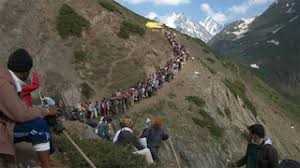
The annual Amarnath Yatra would start from both the traditional Pahalgam and shortest Baltal route in Kashmir on Thursday amid tight security measures.
It is the first pilgrimage after the April 22 terror attack on tourists at Baisaran meadow in Pahalgam in which 25 tourists and a local pony wala were killed.
In wake of the attack, registration for Amarnath pilgrims has seen a dip of over 10 per cent .
Lieutenant Governor Manoj Sinha in the morning flagged off the first batch of pilgrims from the Bhagwati Nagar Base Camp in Jammu.
The pilgrims will proceed toward the Amarnath cave shrine tomorrow, officially beginning the 38-day yatra.
The cave shrine located deep in south Kashmir Himalayas is accessible via Pahalgam in Anantnag and Sonamarg in Ganderbal routes.
Pilgrims visiting the Cave through Pahalgam will have to pass through the south Kashmir districts of Kulgam and Anantnag, while those using the Baltal Sonamarg route have to traverse Kulgam, Anantnag, Pulwama, Srinagar, Bandipore, and Ganderbal.
Tight security arrangements have been made by security agencies along the twin Yatra routes.
The security has also been increased along the strategic Jammu-Srinagar National Highway. Besides increasing the number of security personnel on ground, the authorities have also strengthened the Facial Recognition Surveillance network along the highway.
The pilgrims have been tagged with RFID devices for real-time tracking.
The Jammu and Kashmir government has declared all routes to the Amarnath cave shrine as “no-fly zones,” prohibiting the use of any aerial devices, including drones and balloons, throughout the yatra.
Joint police control rooms have also been set up along the two routes for enhanced coordination among the security agencies. The control rooms oversee live CCTV footage from the cameras installed along twin routes and the National Highway.
A security official said fool proof arrangements have been put in place including deploying additional security men and using sophisticated equipment to ensure safe, smooth and peaceful conduct of the 38-day yatra, which will culminate on August 9 on the occasion of Raksha Bandhan.
Police, meanwhile, have asked the pilgrims to travel only in designated convoys originating from Bhagwati Nagar, Batal and Nunwan Base camps.
“The Yatris arriving long before the scheduled date are advised to arrive reasonably prior to their day of yatra,” a police spokesperson said.
The annual Amarnath Yatra would start from both the traditional Pahalgam and shortest Baltal route in Kashmir on Thursday amid tight security measures.
It is the first pilgrimage after the April 22 terror attack on tourists at Baisaran meadow in Pahalgam in which 25 tourists and a local pony wala were killed.
In wake of the attack, registration for Amarnath pilgrims has seen a dip of over 10 per cent .
Lieutenant Governor Manoj Sinha in the morning flagged off the first batch of pilgrims from the Bhagwati Nagar Base Camp in Jammu.
The pilgrims will proceed toward the Amarnath cave shrine tomorrow, officially beginning the 38-day yatra.
The cave shrine located deep in south Kashmir Himalayas is accessible via Pahalgam in Anantnag and Sonamarg in Ganderbal routes.
Pilgrims visiting the Cave through Pahalgam will have to pass through the south Kashmir districts of Kulgam and Anantnag, while those using the Baltal Sonamarg route have to traverse Kulgam, Anantnag, Pulwama, Srinagar, Bandipore, and Ganderbal.
Tight security arrangements have been made by security agencies along the twin Yatra routes.
The security has also been increased along the strategic Jammu-Srinagar National Highway. Besides increasing the number of security personnel on ground, the authorities have also strengthened the Facial Recognition Surveillance network along the highway.
The pilgrims have been tagged with RFID devices for real-time tracking.
The Jammu and Kashmir government has declared all routes to the Amarnath cave shrine as “no-fly zones,” prohibiting the use of any aerial devices, including drones and balloons, throughout the yatra.
Joint police control rooms have also been set up along the two routes for enhanced coordination among the security agencies. The control rooms oversee live CCTV footage from the cameras installed along twin routes and the National Highway.
A security official said fool proof arrangements have been put in place including deploying additional security men and using sophisticated equipment to ensure safe, smooth and peaceful conduct of the 38-day yatra, which will culminate on August 9 on the occasion of Raksha Bandhan.
Police, meanwhile, have asked the pilgrims to travel only in designated convoys originating from Bhagwati Nagar, Batal and Nunwan Base camps.
“The Yatris arriving long before the scheduled date are advised to arrive reasonably prior to their day of yatra,” a police spokesperson said.
© Copyright 2023 brighterkashmir.com All Rights Reserved. Quantum Technologies